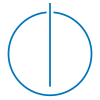TUM Department of Informatics
The TUM Department of Informatics (TUM IN) is a department of the Technical University of Munich, located at its Garching campus. Its field is computer science and related disciplines, with the German term informatics being practically synonymous with the Anglo-American computer science.[3] With 7,347 students, it is the largest department or school at the university.
 | |
| Type | Public |
|---|---|
| Established | 1967 (first courses) 1992 (independent department) |
| Dean | Hans-Joachim Bungartz |
Academic staff | 45 professors 454 research assistants (2019)[1] |
| Students | 7,347 (2020)[2] |
| Location | , , |
| Affiliations | TUM |
| Website | in.tum.de |
 | |
History
The first courses in computer science at the Technical University of Munich were offered in 1967 at the Department of Mathematics, when Friedrich L. Bauer introduced a two-semester lecture titled Information Processing. In 1968, Klaus Samelson started offering a second lecture cycle titled Introduction to Informatics.[4]
By 1992, the computer science department had separated from the Department of Mathematics to form an independent Department of Informatics.[4]
In 2002, the Department relocated from its old campus in the Munich city center to the new building on the Garching campus.[4]
In 2017, the Department celebrated 50 Years of Informatics Munich with a series of lectures and ceremonies, together with the Ludwig Maximilian University of Munich and the Bundeswehr University Munich.[4]
Building

The Department of Informatics shares a building with the Department of Mathematics.
In the building, two massive parabolic slides run from the fourth floor to the ground floor. Their shape corresponds to the equation and is supposed to represent the "connection of science and art".[5]

Chairs
The department consists of 31 chairs:[6]
- Engineering Software for Decentralized Systems
- Formal Languages, Compiler Construction, Software Construction
- Database Systems
- Software & Systems Engineering
- Scientific Computing
- Robotics, Artificial Intelligence and Real-time Systems
- Foundations of Software Reliability and Theoretical Computer Science
- Network Architectures and Services
- Computer Vision and Artificial Intelligence
- Computer architecture and Parallel Systems
- Connected Mobility
- Bioinformatics
- Application and Middleware Systems
- Theoretical Computer Science
- Computer Graphics and Visualization
- Computer Aided Medical Procedures
- Information Systems and Business Process Management
- Decision Sciences & Systems
- Software Engineering for Business Information Systems
- IT Security
- Logic and Verification
- Software Engineering
- Sensor Based Robot Systems and Intelligent Assistance Systems
- Cyber Trust
- Data Science and Engineering
- Data Analytics and Machine Learning
- Robotics Science and Systems Intelligence (joint appointment with the Department of Electrical Engineering)
- Visual Computing
- Computational Molecular Medicine
- Law and Security in Digitization (joint appointment with the School of Governance)
- Artificial Intelligence in Healthcare and Medicine (joint appointment with the Department of Electrical Engineering)
Rankings
| University rankings | |||||||||||||||||||||||
|---|---|---|---|---|---|---|---|---|---|---|---|---|---|---|---|---|---|---|---|---|---|---|---|
| By subject – Global & National | |||||||||||||||||||||||
| |||||||||||||||||||||||
| CHE Ranking 2020 – National | |||||||||||||||||||||||
| |||||||||||||||||||||||
| |||||||||||||||||||||||
The TUM Department of Informatics has been consistently rated the top computer science department in Germany by major rankings.[7][8][9] Globally, it is rated No. 36 (QS),[7] No. 14 (THE),[8] and No. 51-75 (ARWU).[9]
In the 2020 national CHE University Ranking, the department is among the top rated departments for computer science and business informatics, being rated in the top group for the majority of criteria.[10][11]
Notable people
Seven faculty members of the Department of Informatics have been awarded the Gottfried Wilhelm Leibniz Prize, one of the highest endowed research prizes in Germany with a maximum of €2.5 million per award:
- 2020 – Thomas Neumann
- 2016 – Daniel Cremers
- 2008 – Susanne Albers
- 1997 – Ernst Mayr
- 1995 – Gerd Hirzinger
- 1994 – Manfred Broy
- 1991 – Karl-Heinz Hoffmann (mathematician)
Friedrich L. Bauer was awarded the 1988 IEEE Computer Society Computer Pioneer Award for inventing the stack data structure. Gerd Hirzinger was awarded the 2005 IEEE Robotics and Automation Society Pioneer Award. Hans-Arno Jacobsen and Burkhard Rost were awarded the Alexander von Humboldt Professorship in 2011 and 2008, respectively. Rudolf Bayer was known for inventing the B-tree and Red–black tree.
References
- "The Department of Informatics in Facts and Figures 2019". TUM Department of Informatics. Retrieved 22 December 2020.
- "TUM Facts & figures". Technische Universität München. Retrieved 22 December 2020.
- "Are We All In The Same Boat? ACM & Informatics Europe" (PDF). Association for Computing Machinery. 8 May 2017.
- "History". TUM Department of Informatics. Retrieved 22 December 2020.
- Hoffmann, Sabine (4 October 2002). "Akademiker-Bespaßung: Rutschpartie zum Café Latte". Der Spiegel (in German). Retrieved 22 December 2020.
- "Chairs". TUM Department of Informatics. Retrieved 22 December 2020.
- "QS World University Rankings by Subject 2020: Computer Science & Information Systems". QS World University Rankings. Retrieved 22 December 2020.
- "World University Rankings 2021 by subject: computer science". Times Higher Education World University Rankings. Retrieved 22 December 2020.
- "ShanghaiRanking's Global Ranking of Academic Subjects 2020 - Computer Science & Engineering". Academic Ranking of World Universities. Retrieved 22 December 2020.
- "Subject information about Studying Computer Science in Germany". CHE University Ranking. Retrieved 31 December 2020.
- "Studying Business Informatics in Germany". CHE University Ranking. Retrieved 31 December 2020.
External links
 Media related to TUM Department of Informatics building at Wikimedia Commons
Media related to TUM Department of Informatics building at Wikimedia Commons